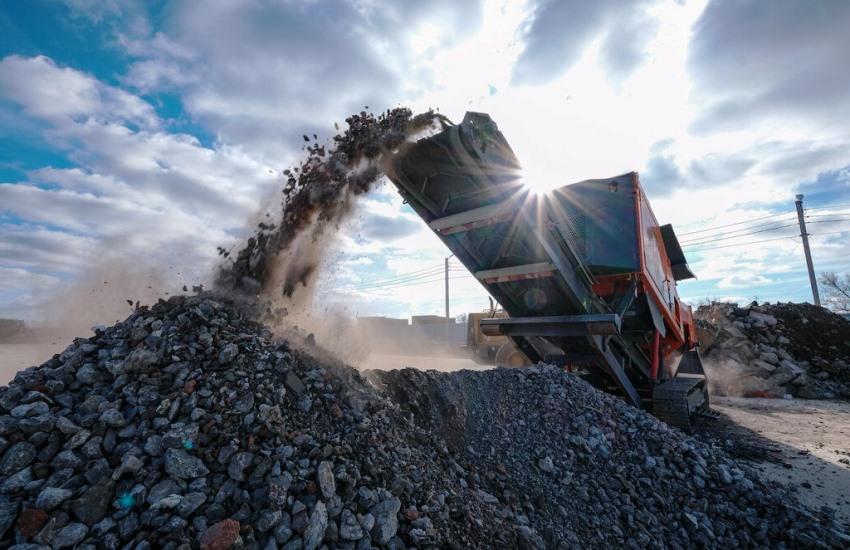«Кому интересны эти окаменелости, кроме палеонтологов?», — возможно, подумает читатель, которого не легко удивить. Но не спешите. Окаменелости – это не просто «скучные камни», это еще и своего рода слепок первозданного мира. А иногда в них находятся очень интересные создания, о которых мы вам расскажем и покажем на фотографиях в этой статье про топ-10 самых удивительных находок в окаменелостях.
10. Дракон охотится на динозавра

Когда-то динозавры были хозяевами Земли. И все же им приходилось делить планету с существами, которые, если бы им представилась возможность, откусили бы от этих ужасных ящериц маленький или большой кусочек.
Вот и первый экземпляр в нашем рейтинге удивительных окаменелостей демонстрирует, как змея из рода Sanajeh indicus (жившего около 67 млн. лет назад) решила совершить гастрономический тур в гнездо динозавров.
Длина змеи составляла 3.5 метра, и нашли ее рядом с кладкой яиц динозавров-зауроподов. Другие окаменелости, найденные поблизости, показывают, что другие змеи Sanajeh indicus обвились вокруг других яиц, так что, похоже, детёныши динозавров были их любимым лакомством.
9. Паразит сбегает от умирающего хозяина
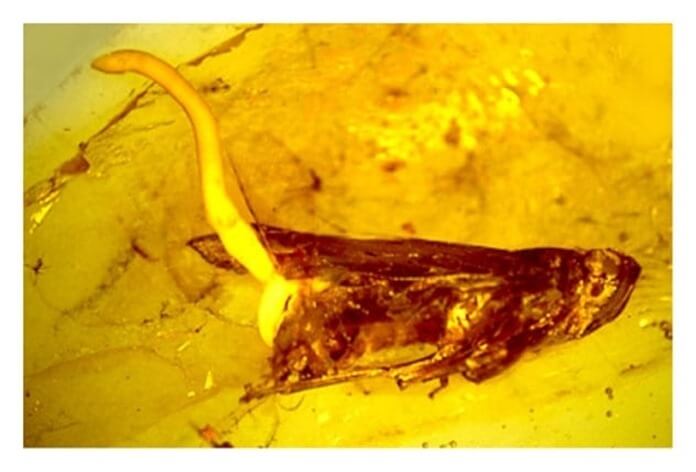
Паразиты — удивительные, хотя и очень неприятные существа. Вместо того, чтобы искать себе еду, они прекрасно приспособлены к краже питательных веществ у других существ. Иногда они перемещаются внутри своих хозяев, чтобы полакомиться чем-то особо вкусным или быть в безопасности.
Когда паразитическая нематода чувствует, что ее хозяин умирает, она часто пытается вылезти из нее. Вот и в этом янтаре навечно запечатлелось подобное событие. Когда маленькая цикада оказалась в густом древесном соке, червь, заполнивший почти всю полость ее тела, начал свой путь наружу. К несчастью для паразита, он не мог вырваться из сока, как и его хозяин. Оба они погибли 35 миллионов лет назад.
8. Черепахи во время спаривания

Для двух несчастных черепах момент спаривания был больше, чем просто «маленькой смертью». Кажется, эта парочка любила экстрим, иначе как объяснить то, что она решила спариваться во время купания в вулканическом озере, или может туда случайно свалились?
До того, как исследования определили пол этих черепах, некоторые ученые предполагали, что черепахи погибли во время какого-то странного боя.
7. Бой динозавров

Велоцирапторы были не совсем той угрозой, которую они представляли в «Парке Юрского периода». Во-первых, они были небольшого размера (до 1,5 м в длину, 40-70 см в высоту), поэтому маловероятно, что они бы охотились на людей, по крайней мере, в одиночку. Но длинный серповидный коготь на ноге делал их опасными противниками для существ, с которыми велоцирапторы могли справиться.
Для одного протоцератопса, жившего около 74 миллионов лет назад в древней Монголии, встреча с велоцираптором была смертельной.
Коготь велоцираптора вонзился в горло жертве, что, вероятно, было бы «фаталити». Но протоцератопс не остался в долгу, и похоже, укусил нападавшего за лапу с такой силой, что сломал кости велоцираптора.
Ученые считают, что пока эти динозавры боролись за свою жизнь, на них внезапно обрушился большой массив суши (предположительно песчаный бархан).
6. Общая нора
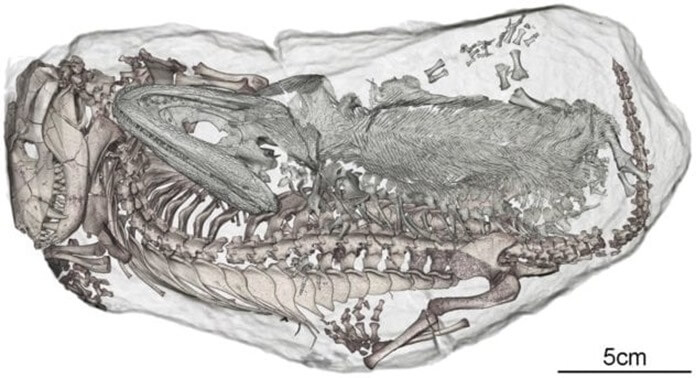
Первым животным, обнаруженным внутри 250-миллионолетней норы, было прото-млекопитающее под названием тринаксодон. Предположительно это животное и было хозяином норы. Но совсем рядом с ним была амфибия брумистега.
Поскольку брумистега — именно тот вид животных, на которых охотился бы хищный тринаксодон, эти двое вряд ли были товарищами по койке. Ключом к пониманию того, почему же они делили одну нору на двоих, были травмы на амфибии. Два укуса на макушке показали, что на нее напали, но следы укусов не соответствуют тринаксодону.
Исследователи полагают, что тринаксодон, вероятно, спал или находился в состоянии оцепенения, когда раненая брумистега заползла в его нору. К сожалению, оба обитателя норы попали в мутную жижу, когда внезапное наводнение похоронило их заживо.
5. Охотник стал добычей

Когда птерозавр поймал маленькую рыбу, вторая, гораздо более крупная рыба, вылетела из воды и схватила самого птерозавра. Удивительное происшествие, которое закончилось фатально для всех участников.
4. Следы в Лаэтоли
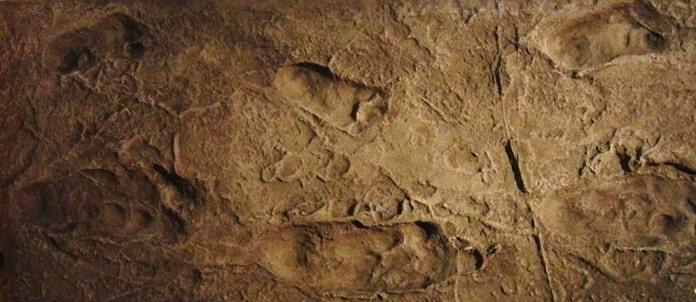
Открытие следов в местечке Лаэтоли (Танзания) в 1978 году предоставило убедительные доказательства того, что наши далекие предки передвигались на двух ногах по крайней мере 3,7 миллиона лет назад.
Эти следы, скорее всего, были оставлены афарским австралопитеком, который прошел по слою пепла после недавнего извержения вулкана. Слабые африканские дожди, вероятно, увлажнили пепел, превратив его в глину и идеально сохранив для науки.
3. Доисторические Помпея
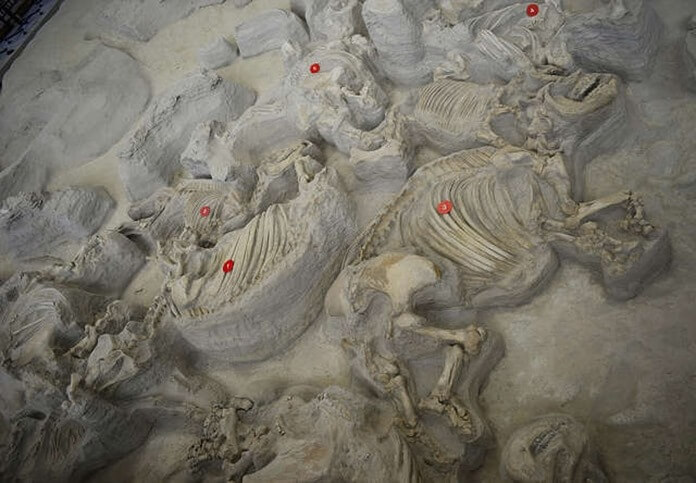
По сравнению со многими другими экспонатами рейтинга самых необычных окаменелостей эта — еще младенец, но ее недостаток в возрасте компенсируется тем, насколько она невероятна.
Около 12 миллионов лет назад в результате извержения вулкана погибло более 200 животных, включая носорогов, первых лошадей, длинношеих верблюдов и журавлей. Их прекрасно сохранившиеся и полностью сочлененные скелеты все еще раскапываются спустя 40 лет после того, как были впервые обнаружены.
2. Самка ихтиозавра рожает на суше
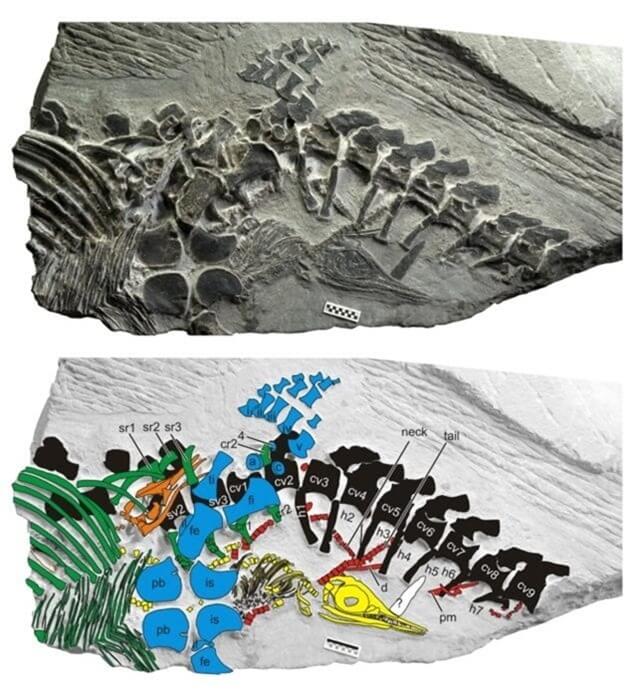
Момент рождения может быть весьма опасным, и существует множество окаменелостей, свидетельствующих о несчастных матерях, умерших во время родов. Иногда эти окаменелости могут многое рассказать о жизни этих существ от рождения до смерти.
Например, было обнаружено много окаменелостей матерей-ихтиозавров и их детенышей сразу после рождения. Большинство из них показывают, что детеныши вылезали из матери хвостом вперед, а это предполагает, что они рождались в море. Однако одна из первых ихтиозавров, жившая 250 миллионов лет назад, была обнаружена, когда рожала детенышей, которые вылуплялись вперед головой.
Поскольку рождение головой встречается только у наземных животных, это говорит о том, что первые ихтиозавры выползали на сушу, чтобы произвести на свет потомство. Впоследствии ихтиозавры превратились в существ, которые жили исключительно в воде.
1. Блоха с бактерией чумы
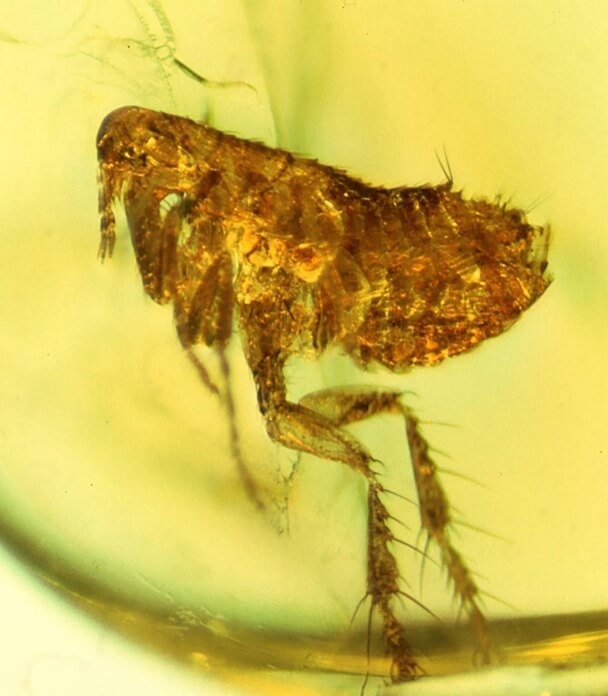
Одной из самых странных окаменелостей исполнилось около 20 миллионов лет. Один из ведущих мировых исследователей янтаря, американский палеоэнтомолог Джордж Пойнар-младший и его коллеги из Университета штата Орегон, обнаружили ее в янтаре из Доминиканской республики.
Доминиканский янтарь — один из самых важных видов янтаря, часто почти прозрачный и получаемый из смолы вымершего дерева Hymenaea protera. Большая часть доминиканского янтаря хранит остатки неотропических лесов, существовавших в этом регионе от 25 до 20 миллионов лет назад.
В этом янтаре уже были найдены многочисленные насекомые, поэтому не было большим сюрпризом найти в нем еще и блоху. А вот открытие смертельной бактерии чумы в теле этого существа исследователей весьма удивило. Пойнар утверждал, что этот микроб, возможно, является предком современной чумной палочки или Yersinia pestis. Далее он заявил, что несколько штаммов болезни эволюционировали и вымерли с течением времени, и, как бы ни была интересна новая находка, ее истинное значение в то время остается загадкой.
Однако он упомянул, что бактерия присутствовала в засохшей капле крови в хоботке блохи. Это говорит о том, что способ передачи чумы был таким же, как и во время самых страшных пандемий в мировой истории.
Возраст находки относит ее к эпохе раннего миоцена, когда разнообразие млекопитающих начало стремительно расти. В то время Доминиканская Республика, возможно, была покрыта густыми тропическими лесами, и этой чумной блохе не повезло, она застряла в свежей смоле.
📚 Не пропустите интересную информацию:
-
От окаменелостей динозавров до подземных рек: 10 открытий в Антарктиде, которые озадачили ученых
В одном из самых суровых географических регионов мира, в самом сердце Антарктиды, скрывается бесчисленное множество тайн, ожидающих своего открытия. На этом континенте 98% площади суши... -
10 популярных отелей Чолаклы, Турция — курорт, где хочется остаться дольше
Турция — страна, в которую возвращаются. Кто-то — ради хамама и пахлавы, кто-то — за ласковым морем и безмятежностью «всё включено». Но есть места, куда... -
Самые дешевые страны для путешествий: топ-12 бюджетных направлений 2025
Мечтаете о путешествиях, но ограничены в бюджете? Самые дешевые страны для путешествий предлагают невероятные впечатления за минимальные деньги. От экзотических пляжей Юго-Восточной Азии до древних... -
Животные которые умеют считать: удивительные математические способности в дикой природе
Многие люди считают, что математика — исключительно человеческая наука. Однако исследования последних десятилетий показывают, что животные которые умеют считать встречаются гораздо чаще, чем мы думали.... -
10 невероятных фактов о пиве, которые перевернут ваше представление о нём
Пиво — напиток с многотысячелетней историей, но даже в наш просвещённый век оно продолжает удивлять. Где-то его варят на основе древних рецептов, где-то — из...




